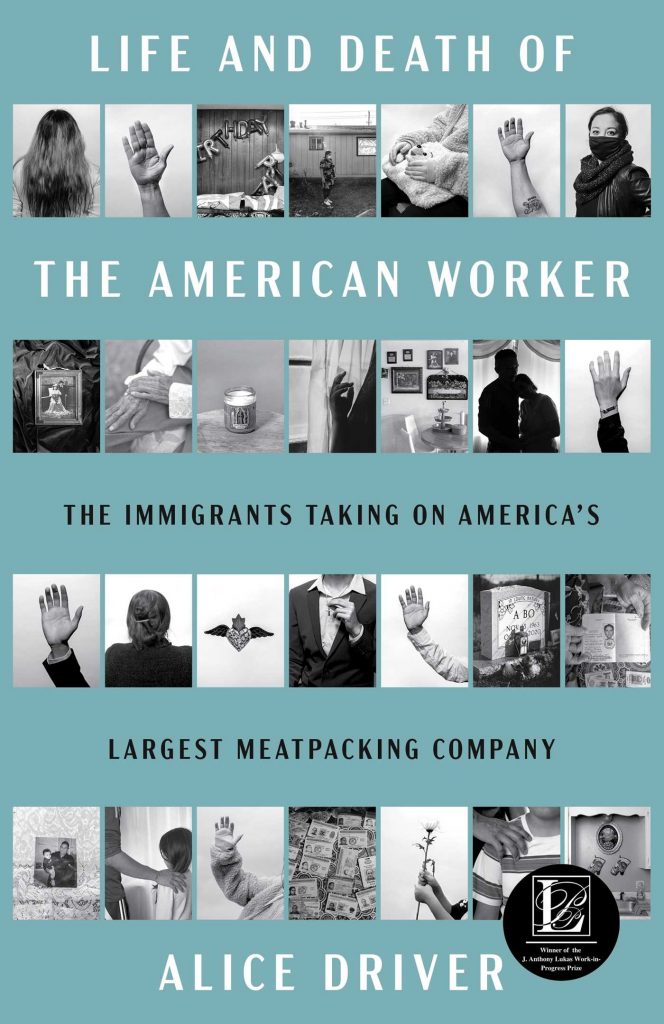Life and Death of the American Worker
Life and Death of the American Worker; The Immigrants Taking on America’s Largest Meatpacking Company, by Alice Driver (New York: One Signal Publishers, 2024)
Food is produced in the United States by a workforce that is in good part immigrant. One major production center is rural Arkansas, in the Ozark Mountains, the headquarters of Tyson Foods, the nation’s largest meatpacker. The Ozarks also feature the town of Oark, investigative journalist Alice Driver’s birthplace, where Central American and Mexican immigrants arrived in the 1970s looking for jobs. In a world of chicken farmers, including her parents, she observed the poultry industry and how companies maximized profits to win a war for survival. The casualties of this conflict included the small farmers and the workers, with “scarred wrists, infected hands, and missing fingers,” and other disabling injuries. Working conditions were reminiscent of those described in Upton Sinclair’s muckraking 1906 novel, The Jungle.
Such is the situation described by Driver in Life and Death of the American Worker. A blistering view of factories run by Tyson Foods in Arkansas, this book resulted from four years of interviews with current and former Tyson workers and their families. Conducted in four languages and reinforced with personal documents provided by interviewees seeking justice, it offers insight into the conditions that also produced a class action lawsuit.

Driver’s description of Tyson is devastating. It includes the employment of undocumented foreign workers as well as nonviolent criminals enrolled in alternative rehabilitative programs, known as “the Chicken Farm,” rather than jail time. The pay for such labor was “little or nothing,” often with a religious rationale.
Politics served as the great facilitator of low pay and other practices friendly to profits. Alluding to Governor Bill Clinton’s personal ties to Tyson, presidential candidate Ross Perot referred to him as “chicken man.” During his governorship of Arkansas, Driver explains, poor regulation of meatpacking led to “the contamination of drinking water and hundreds of miles or rivers and streams.” The author further notes that Arkansas, influenced heavily by Tyson and Walmart, “routinely ranks among the most impoverished states with high infant and maternal mortality rates.”
Coziness with Tyson and other members of “Big Ag” even extended to the White House, regardless of the party in power. It affected the Obama, first Trump, and Biden administrations, resulting in “significant sway over lawmaking.” A key benefit: farm subsidies funded by taxpayers. For Tyson’s workers there were no such advantages, such as from unions. As one worker told Driver, “They won’t let us organize. The truth is people are afraid.” They feared being fired. “They have all the power here. Tyson can buy people or anything they need,” the worker added.
Life and Death of the American Worker reads like fiction. Its revelations include a disastrous chemical leak, highly profitable but of questionable quality chicken nuggets, compulsory on-site work during the COVID-19 pandemic, employee medical care steered to company doctors, high worker job turnover, and numerous other problems. For the immigrant employees who spoke to Driver, their situation seemed hopeless. Their only hope appeared to be a class action suit.
In March 2021 a lawsuit on behalf of sixty-nine former Tyson employees and their relatives held the company accountable for death, illness and emotional distress. The document included the accusation that “Tyson’s lack of concern for safety resulted in widespread infection of COVID.” Nevertheless, on jurisdictional and technical grounds the workers lost their case and Tyson and the meatpacking industry emerged victorious.
In her book Alice Driver calls attention to a tale that should not have to be told at this time. Hers is a forthright account of immigrant workers victimized by economic and political forces beyond their control. With clarity and compassion, she presents a reminder of how humanity can be sacrificed on the altar of greed.
Reviewed by Robert D. Parmet, York College of The City University of New York
